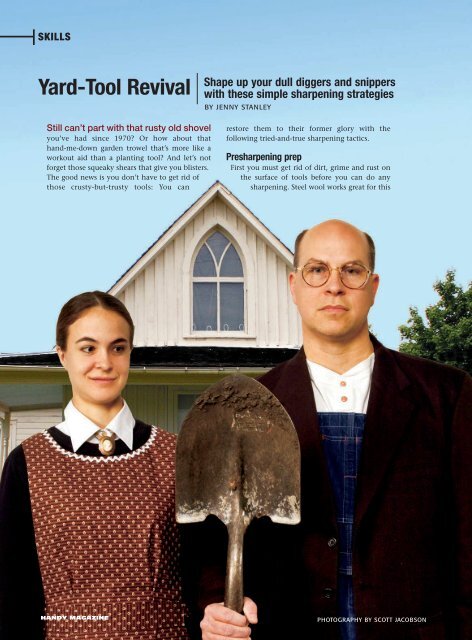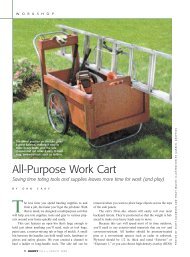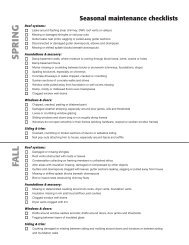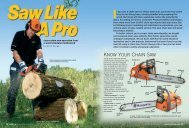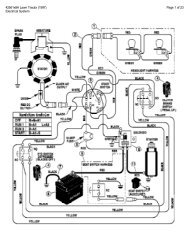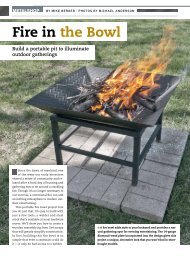Yard-Tool Revival - Handyman Club of America
Yard-Tool Revival - Handyman Club of America
Yard-Tool Revival - Handyman Club of America
Create successful ePaper yourself
Turn your PDF publications into a flip-book with our unique Google optimized e-Paper software.
SKILLS<br />
<strong>Yard</strong>-<strong>Tool</strong> <strong>Revival</strong><br />
Shape up your dull diggers and snippers<br />
with these simple sharpening strategies<br />
BY JENNY STANLEY<br />
Still can’t part with that rusty old shovel<br />
you’ve had since 1970? Or how about that<br />
hand-me-down garden trowel that’s more like a<br />
workout aid than a planting tool? And let’s not<br />
forget those squeaky shears that give you blisters.<br />
The good news is you don’t have to get rid <strong>of</strong><br />
those crusty-but-trusty tools: You can<br />
restore them to their former glory with the<br />
following tried-and-true sharpening tactics.<br />
Presharpening prep<br />
First you must get rid <strong>of</strong> dirt, grime and rust on<br />
the surface <strong>of</strong> tools before you can do any<br />
sharpening. Steel wool works great for this<br />
HANDY MAGAZINE<br />
PHOTOGRAPHY BY SCOTT JACOBSON
1<br />
SHEAR SHARPENING<br />
BY THE NUMBERS<br />
1. Scour the blade surface.<br />
2. Mark the beveled edges; follow the<br />
manufacturer’s original angle, so the<br />
shears continue to work properly. The<br />
marks will disappear as you sharpen.<br />
3. Disassemble the shears. Starting at<br />
a high point on the blade, press a<br />
honing stone down and away from<br />
you along the beveled edge. Continue<br />
in this motion until you’ve achieved the<br />
desired sharpness. Apply a few drops<br />
<strong>of</strong> mineral oil for lubrication and<br />
quicker results.<br />
2 3<br />
The bevel on most diggers can be<br />
found along the back edge. To allow a<br />
longer filing motion, use scrap wood to<br />
prop up the tool you are sharpening.<br />
step. If you don’t have any on hand,<br />
try using a wadded piece <strong>of</strong> aluminum<br />
foil, a wire brush or a rotary<br />
tool with a wire-bristle attachment.<br />
Use a solvent to remove any lingering<br />
traces <strong>of</strong> rust.<br />
Don’t forget about safety gear.<br />
Sparks can fly when you’re grinding<br />
metal, so wear eye and ear protection<br />
and flame-resistant clothing. Note<br />
that gloves are not recommended<br />
when using rotary tools or grinding<br />
wheels because they can get caught<br />
in the fast-moving parts.<br />
File away<br />
Most single-bevel outdoor hand<br />
tools, such as classic and border<br />
shovels, trowels, spades, etc., can be<br />
sharpened with a flat bastard-cut<br />
mill file. (You can find this standard<br />
file at most hardware stores.)<br />
Start by securing the tool to the<br />
work surface using clamps or a vise;<br />
the edge to be sharpened should be<br />
facing up. Press the file down and<br />
away from you along the digging<br />
edge in one steady motion. Use both<br />
hands on the file to help maintain a<br />
consistent angle (top photo, opposite).<br />
Pick up the file and continue<br />
sharpening in this same direction<br />
until a clean metal edge appears<br />
along the entire bevel. To prevent<br />
the file from clogging, dip it in water<br />
frequently. This will also help to cool<br />
and lubricate the tool you are sharpening.<br />
Gently sand <strong>of</strong>f any burrs<br />
Rotary-tool bits quickly grind metal<br />
edges sharp. Remember to hold the<br />
rotary tool steady as you sharpen to<br />
get a consistent bevel angle across<br />
the edge.<br />
using medium-grit sandpaper.<br />
For tools that work best with<br />
finely sharpened blades (pruners,<br />
shears, etc.), a honing stone or<br />
diamond sharpener will help you<br />
achieve more acute angles (see<br />
“Shear Sharpening by the Numbers,”<br />
opposite).<br />
High-speed honing<br />
Rotary tools, electric-drill attachments<br />
and bench grinders are speedier<br />
alternatives for sharpening out-<br />
HANDY M A G A Z I N E
When using a grinding wheel, the more pressure you apply, the faster you sharpen.<br />
Check your progress after each pass to avoid overshaping.<br />
PRESERVE AND PROTECT<br />
After shaving years <strong>of</strong> wear and tear <strong>of</strong>f <strong>of</strong> your favorite outdoor hand<br />
tools, keep them shipshape with these additional maintenance tips:<br />
• Clean tools after each use.<br />
• Lubricate all moving parts and beveled edges before storing.<br />
• Sand wood handles smooth and apply one or two coats <strong>of</strong><br />
weather-resistant finish; replace broken handles.<br />
• Store your tools indoors and in a dry area.<br />
door hand tools. However, if you<br />
choose to use any <strong>of</strong> these highspeed<br />
options, be careful to avoid<br />
overshaping or overheating, which<br />
can ultimately weaken metal tools.<br />
Most rotary tools have accessories<br />
designed specifically for cleaning,<br />
shaping, sharpening and deburring<br />
metal. Be sure to select one that will<br />
give you the most control when<br />
working with each tool. Once you’ve<br />
selected the appropriate accessory,<br />
clamp the tool you are sharpening to<br />
a work surface, turn on the rotary<br />
tool and gently guide it along the<br />
bevel (bottom photo, p. 43). When a<br />
clean metal edge appears and you’re<br />
satisfied with its sharpness, remove<br />
the burrs and you’re done. Follow<br />
this same process if you’re sharpening<br />
with an electric-drill attachment.<br />
A high-speed grinding wheel<br />
(photo, above) is useful for sharpening<br />
your most distressed outdoor<br />
hand tools, as it quickly reshapes<br />
dull and damaged edges. However,<br />
since it is stationary, it does require<br />
a little more skill to hold the tool<br />
you are sharpening at a consistent<br />
angle. Also, water must be applied<br />
frequently at the point <strong>of</strong> friction to<br />
avoid overheating.<br />
Whether you choose to hone<br />
your trusty outdoor tools using hand<br />
files, stones, rotary tools or highspeed<br />
grinders, you’ll surely keep<br />
them looking (and working) sharp<br />
for many years to come. u<br />
SOURCES ONLINE<br />
For online information, go to<br />
www.<strong>Handyman</strong><strong>Club</strong>.com<br />
and click on WEB EXTRAS.<br />
Cooper Hand <strong>Tool</strong>s<br />
(Nicholson files), (919) 362-1670<br />
Dremel<br />
800-437-3635<br />
HANDY MAGAZINE


